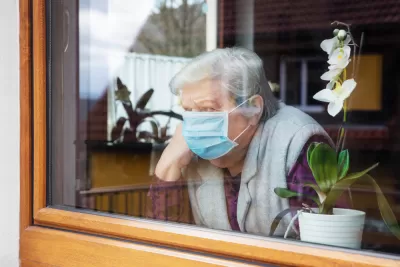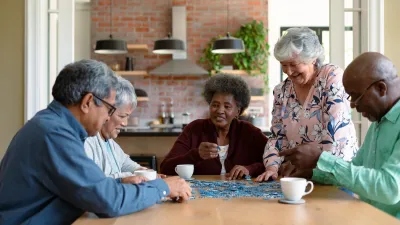A lack of affordable housing and access to services and amenities make it difficult for many seniors to remain in their long-term homes or communities.

A new study from the Harvard Joint Center for Housing Studies (JCHS) reveals “an acute lack of safe, affordable, and accessible housing options” for seniors hoping to ‘age in place.’ As Colleen Walsh explains in Harvard Magazine, “JCHS projects that U.S. households headed by someone more than 80 years old will number 17.5 million in 2038—more than twice the 8.1 million of 2018— accounting for 12 percent of all households.”
Jennifer Molinsky, who directs the JCHS’s Housing an Aging Society Program, says “When we talk about aging in place, we need to remember the home but also the larger place—does it have the amenities and transportation alternatives and walkability and opportunities to engage in the community that you might want or need?” In other words, Molinsky says, “it’s not only about the home and neighborhood, it’s also about ensuring access to the services and supports people need to stay safely there.”
Walsh describes several efforts by researchers, governments, and nonprofits to identify the challenges facing older adults and best practices and strategies for providing them with services and resources, which include listening to seniors themselves when trying to understand their needs. “The new report emphasizes the importance of involving older voices in planning a sustainable future for all seniors.” The report acknowledges the role of the pandemic, which “forced many people to reconsider the physical design, features, and accessibility of houses, apartments, and neighborhoods, including access to fresh air, green space, reliable elevators, and backup generators.” Molinski stresses the importance of housing as a primary factor in seniors’ health and well-being, shifting the focus away from a traditional healthcare-based approach.
FULL STORY: The Senior Housing Shortfall

Maui's Vacation Rental Debate Turns Ugly
Verbal attacks, misinformation campaigns and fistfights plague a high-stakes debate to convert thousands of vacation rentals into long-term housing.

Planetizen Federal Action Tracker
A weekly monitor of how Trump’s orders and actions are impacting planners and planning in America.

San Francisco Suspends Traffic Calming Amidst Record Deaths
Citing “a challenging fiscal landscape,” the city will cease the program on the heels of 42 traffic deaths, including 24 pedestrians.

Defunct Pittsburgh Power Plant to Become Residential Tower
A decommissioned steam heat plant will be redeveloped into almost 100 affordable housing units.

Trump Prompts Restructuring of Transportation Research Board in “Unprecedented Overreach”
The TRB has eliminated more than half of its committees including those focused on climate, equity, and cities.

Amtrak Rolls Out New Orleans to Alabama “Mardi Gras” Train
The new service will operate morning and evening departures between Mobile and New Orleans.
Urban Design for Planners 1: Software Tools
This six-course series explores essential urban design concepts using open source software and equips planners with the tools they need to participate fully in the urban design process.
Planning for Universal Design
Learn the tools for implementing Universal Design in planning regulations.
Heyer Gruel & Associates PA
JM Goldson LLC
Custer County Colorado
City of Camden Redevelopment Agency
City of Astoria
Transportation Research & Education Center (TREC) at Portland State University
Jefferson Parish Government
Camden Redevelopment Agency
City of Claremont





























